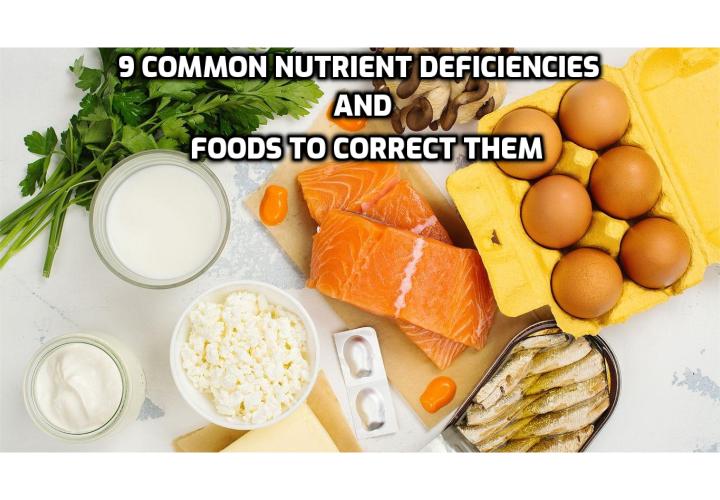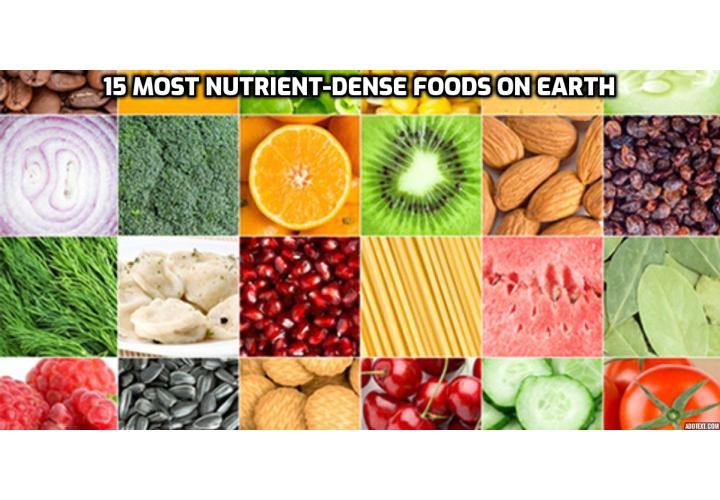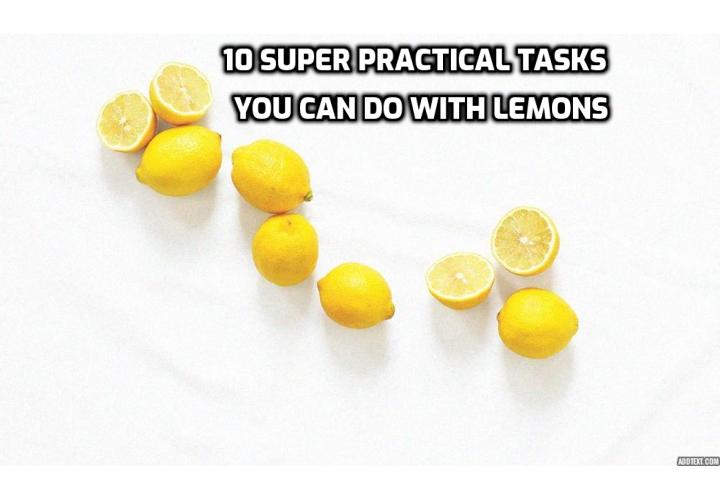Click HERE to Discover these 80 Keto-Friendly and Healthy Slow Cooker Recipes
Are you low in any key nutrients? Check the symptoms of these nine common deficiencies and start eating more of the right vitamin-rich foods.
Low intake levels of certain nutrients are common today due to depleted soil, harsh agricultural practices, excessively refined and processed foods, and over-consumption of nutrient-poor “junk” and fast foods.
When we’re low in key nutrients, we can gain weight and suffer from anything from poor sleep to terrible energy levels.
The good news is that correcting nutrient imbalances can often be done through diet alone. Food is medicine, and correcting deficiencies can have a direct impact on health and how we feel and experience life.
The following nine nutrients are essential for various aspects of health and are the most common nutrients that people fall short in.
1. Magnesium
Magnesium is required in the body for hundreds of chemical reactions ranging from glucose regulation to blood pressure to brain function and more.
While a true deficiency is uncommon, having inadequate amounts can happen due to chronic health problems, medication side effects, low dietary intake, poor nutrient absorption, and excess alcohol consumption. As many as 50 percent of people don’t get enough magnesium each day.
What it’s required for: Muscle function and relaxation, glucose balance, healthy blood pressure, nervous system balance, quality sleep.
Symptoms of Low Intake:
- Weakness and fatigue
- Muscle cramping
- Mood disorders and depression
- Restless legs
- Reduced appetite
- Nausea and vomiting
- Numbness and tingling in extremities
- Heart palpitations or abnormal heart rhythms
Food Sources:
- Halibut
- Almonds
- Cashews
- Avocado
- Salmon
- Pumpkin seeds
- Leafy greens like spinach, Swiss chard
- Dark chocolate
2. Vitamin B12
Deficiency or low levels of B12 can be quite common even in our modern society due to a number of factors including genetic conversion issues, vegan or vegetarian diet, being over age 60, excess use of antacids, autoimmune disease or chronic health disorders, medication side effects, digestive problems, inflammation.
B12 is needed for healthy blood and is an essential nutrient for the nervous system. Low levels of B12 can also be associated with depression and other mood disorders.
What it’s required for: Making red blood cells, nervous system support, energy levels, fighting depression.
Symptoms of Low Intake:
- Nausea
- Reduced appetite
- Pale or jaundiced skin appearance
- Fatigue
- Muscle weakness
- Dizziness
- Shortness of breath
- Nervous system disorders
- Mood disorders
- Depression
- Irritability and mood swings
- Dementia and memory problems
Food Sources:
3. Choline
Choline is a nutrient required for healthy liver, brain and muscular functioning, including heart health. It’s also required for maintaining the basic structure of cells within the body, making it essential for virtually every aspect of well-being.
Choline was only recognized as a nutrient in the late 1990s and has since been considered an essential nutrient unofficially related to the B family of vitamins.
Fewer than 10 percent of the population gets adequate amounts of choline. People at risk for low or deficient levels of choline include people who over-exercise, drink alcohol regularly, are pregnant, are in menopause, or who have chronic, autoimmune, or inflammatory conditions.
What it’s required for: Neurotransmitters, liver health, cell structure, heart health, brain development, metabolism.
Symptoms of Low Intake:
- Liver problems, especially non-alcoholic fatty liver
- Anxiety and other mood disorders
- Inflammation
- Fatigue
- Memory problems
- Nerve problems or damage
Foods Rich in Nutrients:
- Beef and chicken liver
- Eggs
- Cod
- Salmon
- Cauliflower
- Broccoli
4. Vitamin D
Vitamin D, also known as the sun vitamin, can be synthesized in the body after sunlight exposure, but this process only happens at certain times of the year. It also happens less efficiently in people who have darker skin. Nearly 1 billion people don’t get enough vitamin D.
Vitamin D is essential for strong bones and teeth, mental health, and immunity, with people who are deficient facing more frequent colds or infections, as well as an increased risk for autoimmune or chronic disorders.
Vitamin D is one of the few nutrients for which there are not many food sources, and for people with true deficiency or low levels, supplementation may be required.
Because vitamin D is a fat-soluble nutrient, it can be stored in the tissues, which means that over-supplementation can result in toxicity. Getting blood levels of vitamin D tested before supplementation is essential. Work with your medical or nutritional practitioner to assess your current levels.
What it’s required for: Immunity, bone health, mood, mental health.
Symptoms of Low Intake:
- Lowered immunity or frequent infections
- Autoimmune disorders
- Fatigue
- Bone and muscle pain
- Hair loss
- Lower back pain
- Depression or other mood disorders
- Slowed wound healing
- Inflammation
- Bone loss
Food Sources:
- Fatty fish
- Cod liver oil
- Mushrooms
- Egg yolks
- Beef and chicken liver
5. Iron
Iron is one of the most common nutrient deficiencies in the world today, and as much as 30 percent of the world’s population is anemic.
Iron is essential for making red blood cells, and when iron levels are low, the body makes fewer, leading to reduced hemoglobin levels and lower levels of oxygen circulating throughout the body. This is why it can lead to unrelenting fatigue. Iron is also required for making thyroid hormone and having a well-functioning immune system.
Iron deficiency can occur for a number of reasons including low dietary intake, excessive menstruation, pregnancy or childbirth, blood loss, inflammatory bowel disease, or internal bleeding.
In order for dietary iron to absorb well, it should be eaten away from coffee or dairy products and ideally paired with vitamin C-rich foods, like bell peppers or other vegetables or fruits. Some people can be iron deficient not because they lack it in their diet, but because the body cannot adequately absorb or use it.
What it’s required for: Healthy blood, energy, thyroid function, immunity.
Symptoms of Low Intake:
- Fatigue or weakness
- Headaches and dizziness
- Poor overall health and decreased immunity
- Inability to concentrate or focus
- Pale skin
- Shortness of breath
- Heart palpitations or irregular heartbeat
- Dry skin
- Brittle hair and nails
- Restless legs
- Anxiety
- Cold hands and feet
Food Sources:
6. Potassium
Potassium is commonly associated with bananas, and most people know that it can help ease muscle cramps. Potassium is a mineral that functions in the body as an electrolyte, making it responsible for many things ranging from nerve health to fluid balance within the cells to, yes, normal contractional ability of muscles.
While true deficiency is uncommon, as many as 98 percent of Americans are running low on this crucial nutrient, although simply not eating enough is usually not the cause.
Most low levels of potassium occur when the body sheds too much, too fast, and it isn’t replenished quickly enough. Potassium loss can occur in response to vomiting, diarrhea, blood loss, and excessive amounts of sweating.
What it’s required for: Nerve function, muscle contractions, electrolyte balance.
Symptoms of Low Intake:
- Muscle weakness, stiffness, cramping, and/or spasms
- Joint aches and pain
- Fatigue
- Digestive problems like bloating and constipation
- Heart palpitations
- Numbness and tingling in extremities
- Mental fatigue and poor concentration
Food Sources:
- Beet greens
- Yams
- Sweet potatoes
- Avocado
- Bananas
- Nuts
7. Vitamin A
Vitamin A is most known to be essential for eye health, but it’s also required for reproductive health in men and women, immunity, and protection against heart disease. It’s also required for healthy skin cells, which regenerate frequently. Low levels can result in ultra-dry skin and other skin disorders.
Deficiency or low levels of vitamin A are most common in pregnant women, people with cystic fibrosis, breastfeeding mothers, infants and children, and people who suffer from frequent diarrhea.
What it’s required for: Eye health, immunity, skin health, fertility, heart health.
Symptoms of Low Intake:
- Dry skin, acne, and other skin disorders
- Dry eyes
- Night blindness
- Infertility
- Frequent infections and poor immunity
- Poor wound healing
Food Sources:
- Eggs
- Leafy greens like kale and spinach
- Broccoli
- Carrots
- Sweet potatoes
- Pumpkin
- Apricots
- Peaches
- Tomatoes
8. Vitamin B6
Vitamin B6 is required in the body for enzyme reactions that help the body utilize energy from food. It’s also vital for nervous system function and immunity.
B6 works as an antioxidant in the body, helping to protect against heart disease, cancer, and other chronic diseases.
Vitamin B6 works in conjunction with B12 but can have its own negative impact when low levels are present. Most sources of B6 come from animal products, so people who are vegetarian or vegan could be prone to deficiencies.
Other people at risk for low levels of B6 are smokers, those who are overweight, drink alcohol regularly, or are pregnant.
What it’s required for: Energy, nervous system support, immunity, heart health.
Symptoms of Low Intake:
- Fatigue
- Rashes and skin disorders
- Cracks around the mouth and lips
- Mood disorders like anxiety and depression
- Reduced immunity
- Tingling and pain in the extremities
- Seizures
- Inflammation
Food Sources:
- Poultry
- Pork
- Halibut
- Red meat
- Salmon
- Bananas
9. Selenium
Selenium is a mineral that is not commonly discussed but is no less vital for health. It acts as an antioxidant in the body, which protects cells from damage. It’s also vital for countering the physical effects of stress, protecting heart health, fighting Alzheimer’s, and reducing the risk of cancer.
Selenium is also vital for thyroid health since thyroid tissue contains higher amounts of selenium than any other organ. It’s especially vital for people with autoimmune thyroid disease since it protects the organ from sustaining excess oxidative damage and promoting the proper production of hormones.
People who are most prone to low levels of selenium include those who eat mostly refined or processed foods, have bowel disorders like Crohn’s disease, or who have cancer or other chronic or immune-related deficiency syndromes.
What it’s required for: Thyroid health, disease protection, mental cognition, immunity.
Symptoms of Low Intake:
- Thyroid problems
- Muscle weakness
- Fatigue
- Mental fog
- Hair loss
- Poor immunity and frequent infections
Food Sources:
- Brazil nuts
- Halibut
- Oysters
- Sunflower seeds
- Chicken
- Eggs
- Sardines
Watch this video – Food Combining tips | How to improve absorption of nutrients | Fighting nutrient deficiencies
Written by Megan Patiry
Author Bio:
Aimee McNew is a Certified Nutritionist who specializes in women’s health, thyroid problems, infertility, and digestive wellness. She ate her way back to health using a Paleo diet, lost 80 pounds, and had a healthy baby after numerous miscarriages. She focuses on simple nutrition practices that promote long-lasting results.
A lot of people have gotten results from the Keto diet, and enjoyed the foods that it has to offer. However, many of the people who are following this diet have a hard time finding the recipes that they need, especially ones that are quick and easy to complete.
Fortunately, Kelsey Ale, noticed this problem, and decided to do something about it. She’s found that making recipes in a slow cooker gives you meals which are not only delicious, but also take very little time to make. Mostly you just put a few simple ingredients in the slow cooker, and let it do the rest.To find out more, click on – Keto Slow Cooker Cookbook





